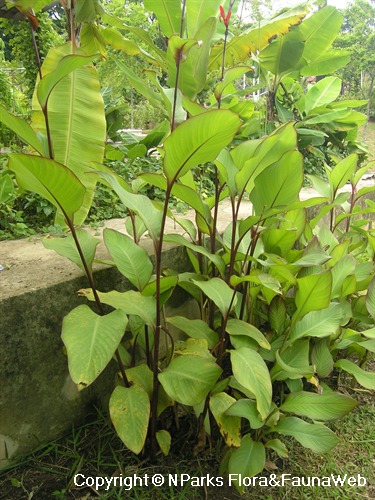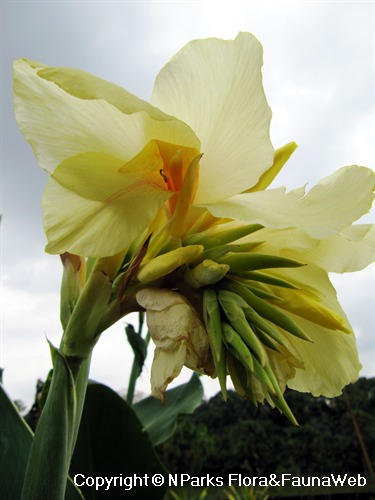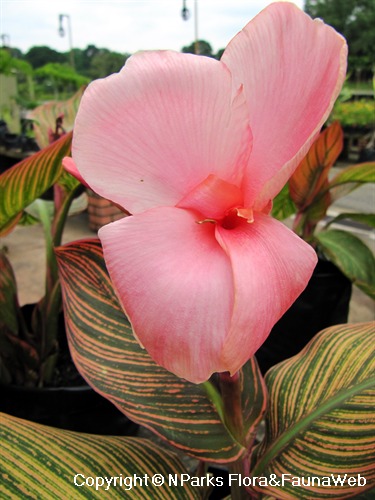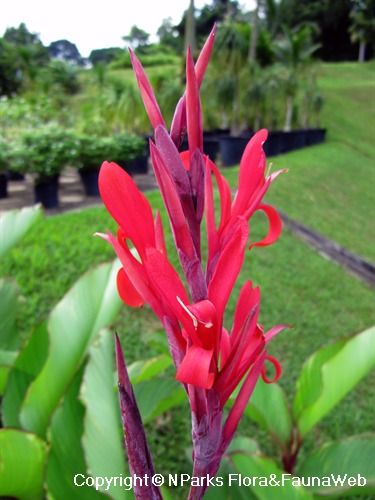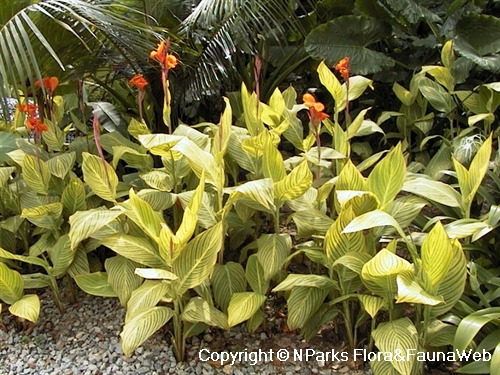
Name
Classifications and Characteristics
| Plant Division | Angiosperms (Flowering Seed Plants) (Monocotyledon) |
|---|---|
| Plant Growth Form | Herbaceous Plant |
| Lifespan (in Singapore) | Perennial |
| Mode of Nutrition | Autotrophic |
| Maximum Height | 1.2 m to 1.8 m |
Biogeography
| Native Distribution | Of horticultural origin |
|---|
Description and Ethnobotany
| Growth Form | It is a perennial, rhizomatous herbaceous plant, up to 1.5 m tall. |
|---|---|
| Foliage | Its leaves are ovate, variegated, with yellow strips occurring along the veins. |
| Flowers | Its erect inflorescence has red bracts and orange flowers. |
| Etymology | The genus Canna is derived from Greek name for a certain type of reed. |
Landscaping Features
| Desirable Plant Features | Ornamental Flowers, Ornamental Foliage |
|---|---|
| Landscape Uses | Container Planting, Parks & Gardens, Swimming Poolside |
| Thematic Landscaping | Bioswales / Sunken Garden |
Plant Care and Propagation
| Light Preference | Full Sun |
|---|---|
| Water Preference | Lots of Water, Moderate Water |
| Plant Growth Rate | Moderate |
| Rootzone Tolerance | Waterlogged Soils (Drains Site), Moist Soils, Fertile Loamy Soils |
| Pest(s) | Sucking Insects, Chewing Insects |
| Propagation Method | Division |
Foliar
| Foliage Retention | Evergreen |
|---|---|
| Mature Foliage Colour(s) | Green, Yellow / Golden |
| Mature Foliage Texture(s) | Thin |
| Foliar Type | Simple / Unifoliate |
| Foliar Shape(s) | Non-Palm Foliage (Ovate) |
| Foliar Venation | Parallel |
| Foliar Margin | Entire |
| Leaf Area Index (LAI) for Green Plot Ratio | 3.5 (Shrub & Groundcover - Monocot) |
Non - Foliar and Storage
| Specialised Storage Organ(s) | Underground (Rhizome) |
|---|
Floral (Angiosperm)
| Flower & Plant Sexuality | Bisexual Flowers |
| Flower Colour(s) | Orange, Red |
|---|---|
| Flower Grouping | Cluster / Inflorescence |
| Flowering Period | Free-Flowering |
| Flowering Habit | Polycarpic |
Image Repository
Others
| Master ID | 484 |
|---|---|
| Species ID | 1780 |
| Flora Disclaimer | The information in this website has been compiled from reliable sources, such as reference works on medicinal plants. It is not a substitute for medical advice or treatment and NParks does not purport to provide any medical advice. Readers should always consult his/her physician before using or consuming a plant for medicinal purposes. |

